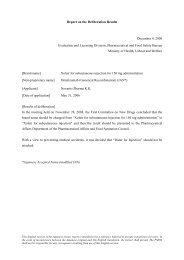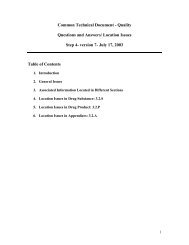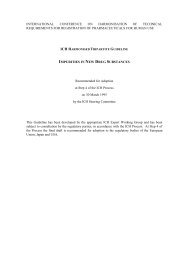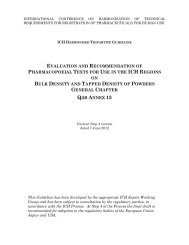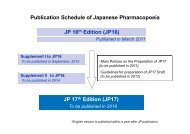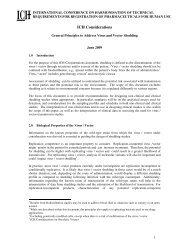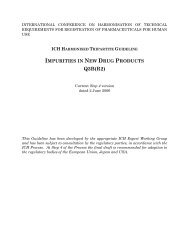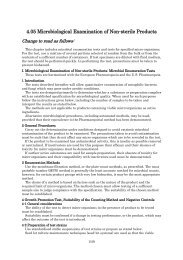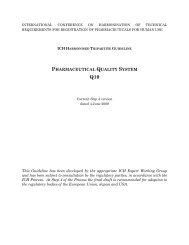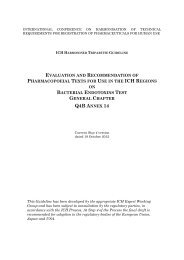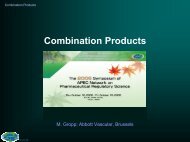stability testing of new drug substances and products q1a(r2)
stability testing of new drug substances and products q1a(r2)
stability testing of new drug substances and products q1a(r2)
- No tags were found...
You also want an ePaper? Increase the reach of your titles
YUMPU automatically turns print PDFs into web optimized ePapers that Google loves.
INTERNATIONAL CONFERENCE ON HARMONISATION OF TECHNICALREQUIREMENTS FOR REGISTRATION OF PHARMACEUTICALS FOR HUMANUSEICH HARMONISED TRIPARTITE GUIDELINESTABILITY TESTING OFNEW DRUG SUBSTANCES AND PRODUCTSQ1A(R2)Current Step 4 versiondated 6 February 2003This Guideline has been developed by the appropriate ICH Expert Working Group <strong>and</strong>has been subject to consultation by the regulatory parties, in accordance with the ICHProcess. At Step 4 <strong>of</strong> the Process the final draft is recommended for adoption to theregulatory bodies <strong>of</strong> the European Union, Japan <strong>and</strong> USA.
Q1A(R2)Document HistoryFirstCodificationHistory Date NewCodificationNovembe<strong>r2</strong>005Q1 Approval by the Steering Committee under Step 2<strong>and</strong> release for public consultation.Q1A Approval by the Steering Committee under Step 4<strong>and</strong> recommendation for adoption to the threeICH regulatory bodies.Q1 was renamed Q1A.16September199227 October1993Q1Q1AQ1A(R)Approval by the Steering Committee <strong>of</strong> the firstrevision under Step 2 <strong>and</strong> release for publicconsultation.7 October1999Q1A(R1)Q1A(R)Approval by the Steering Committee <strong>of</strong> the firstrevision under Step 4 <strong>and</strong> recommendation foradoption to the three ICH regulatory bodies.8Novembe<strong>r2</strong>000Q1A(R1)Current Step 4 versionQ1A(R2)Approval by the Steering Committee <strong>of</strong> the secondrevision directly under Step 4 without furtherpublic consultation, to include consequences <strong>of</strong> theadoption <strong>of</strong> Q1F (Stability Data Package forRegistration Applications in Climatic Zones III <strong>and</strong>IV), <strong>and</strong> recommendation for adoption to the threeICH regulatory bodies.6 February2003Q1A(R2)
COVER NOTE FOR REVISION OF Q1A(R)STABILITY TESTING OFNEW DRUG SUBSTANCES AND PRODUCTSThe purpose <strong>of</strong> this note is to outline the changes made in Q1A(R) that result fromadoption <strong>of</strong> ICH Q1F “Stability Data Package for Registration Applications inClimatic Zones III <strong>and</strong> IV”. These changes are:1. The intermediate storage condition has been changed from 30°C ± 2°C/60%RH ± 5% RH to 30°C ± 2°C/65% RH ± 5% RH in the following sections:• 2.1.7.1 Drug Substance - Storage Conditions - General Case• 2.2.7.1 Drug Product - Storage Conditions - General Case• 2.2.7.3 Drug <strong>products</strong> packaged in semi-permeable containers• 3 Glossary - “Intermediate <strong>testing</strong>”2. 30°C ± 2°C/65% RH ± 5% RH can be a suitable alternative long-term storagecondition to 25°C ± 2°C/60% RH ± 5% in the following sections:• 2.1.7.1 Drug Substance - Storage Conditions - General Case• 2.2.7.1 Drug Product - Storage Conditions - General Case3. 30°C ± 2°C/35% RH ± 5% RH has been added as a suitable alternative longtermstorage condition to 25°C ± 2°C/40% RH ± 5% <strong>and</strong> the correspondingexample for the ratio <strong>of</strong> water-loss rates has been included in the followingsection:• 2.2.7.3 Drug <strong>products</strong> packaged in semi-permeable containersMid-stream switch <strong>of</strong> the intermediate storage condition from 30°C ± 2°C/60% RH ±5% RH to 30°C ± 2°C/65% RH ± 5% RH can be appropriate provided that therespective storage conditions <strong>and</strong> the date <strong>of</strong> the switch are clearly documented <strong>and</strong>stated in the registration application.It is recommended that registration applications contain data from complete studiesat the intermediate storage condition 30°C ± 2°C/65% RH ± 5% RH, if applicable, bythree years after the date <strong>of</strong> publication <strong>of</strong> this revised guideline in the respective ICHtripartite region.
STABILITY TESTING OFNEW DRUG SUBSTANCES AND PRODUCTSICH Harmonised Tripartite GuidelineFirst Recommended for Adoption at Step 4 <strong>of</strong> the ICH Process on 27 October 1993.Revised under Step 2 <strong>of</strong> the ICH Process on 7 October 1999 <strong>and</strong> Recommended forAdoption at Step 4 <strong>of</strong> the ICH Process on 8 November 2000.This guideline has been Revised a second time <strong>and</strong> has reached Step 4 <strong>of</strong> the ICHProcess at the ICH Steering Committee meeting on 6 February 2003. It isrecommended for adoption to the three regulatory parties to ICHTABLE OF CONTENTS1. INTRODUCTION..................................................................................................... 11.1. Objectives <strong>of</strong> the Guideline........................................................................................ 11.2. Scope <strong>of</strong> the Guideline................................................................................................ 11.3. General Principles...................................................................................................... 12. GUIDELINES ....................................................................................................... 12.1. Drug Substance ....................................................................................................... 12.1.1. General ....................................................................................................... 12.1.2. Stress Testing ................................................................................................. 12.1.3. Selection <strong>of</strong> Batches........................................................................................ 22.1.4. Container Closure System ............................................................................. 22.1.5. Specification.................................................................................................... 22.1.6. Testing Frequency .......................................................................................... 32.1.7. Storage Conditions ......................................................................................... 32.1.8. Stability Commitment.................................................................................... 52.1.9. Evaluation ....................................................................................................... 52.1.10. Statements/Labeling ...................................................................................... 6i
TStability Testing <strong>of</strong> New Drug Substances <strong>and</strong> Products2.2. Drug Product .......................................................................................................62.2.1. General .......................................................................................................62.2.2. Photo<strong>stability</strong> Testing.....................................................................................62.2.3. Selection <strong>of</strong> Batches ........................................................................................62.2.4. Container Closure System ..............................................................................72.2.5. Specification.....................................................................................................72.2.6. Testing Frequency...........................................................................................72.2.7. Storage Conditions ..........................................................................................82.2.8. Stability Commitment...................................................................................122.2.9. Evaluation .....................................................................................................122.2.10. Statements/Labeling .....................................................................................133. GLOSSARY .....................................................................................................134. REFERENCES .....................................................................................................17ii
STABILITY TESTING OF NEW DRUG SUBSTANCES AND PRODUCTS1. INTRODUCTION1.1. Objectives <strong>of</strong> the GuidelineThe following guideline is a revised version <strong>of</strong> the ICH Q1A guideline <strong>and</strong> defines the<strong>stability</strong> data package for a <strong>new</strong> <strong>drug</strong> substance or <strong>drug</strong> product that is sufficient for aregistration application within the three regions <strong>of</strong> the EC, Japan, <strong>and</strong> the UnitedStates. It does not seek necessarily to cover the <strong>testing</strong> for registration in or export toother areas <strong>of</strong> the world.The guideline seeks to exemplify the core <strong>stability</strong> data package for <strong>new</strong> <strong>drug</strong><strong>substances</strong> <strong>and</strong> <strong>products</strong>, but leaves sufficient flexibility to encompass the variety <strong>of</strong>different practical situations that may be encountered due to specific scientificconsiderations <strong>and</strong> characteristics <strong>of</strong> the materials being evaluated. Alternativeapproaches can be used when there are scientifically justifiable reasons.1.2. Scope <strong>of</strong> the GuidelineThe guideline addresses the information to be submitted in registration applicationsfor <strong>new</strong> molecular entities <strong>and</strong> associated <strong>drug</strong> <strong>products</strong>. This guideline does notcurrently seek to cover the information to be submitted for abbreviated or abridgedapplications, variations, clinical trial applications, etc.Specific details <strong>of</strong> the sampling <strong>and</strong> <strong>testing</strong> for particular dosage forms in theirproposed container closures are not covered in this guideline.Further guidance on <strong>new</strong> dosage forms <strong>and</strong> on biotechnological/biological <strong>products</strong> canbe found in ICH guidelines Q1C <strong>and</strong> Q5C, respectively.1.3. General PrinciplesThe purpose <strong>of</strong> <strong>stability</strong> <strong>testing</strong> is to provide evidence on how the quality <strong>of</strong> a <strong>drug</strong>substance or <strong>drug</strong> product varies with time under the influence <strong>of</strong> a variety <strong>of</strong>environmental factors such as temperature, humidity, <strong>and</strong> light, <strong>and</strong> to establish a retestperiod for the <strong>drug</strong> substance or a shelf life for the <strong>drug</strong> product <strong>and</strong>recommended storage conditions.The choice <strong>of</strong> test conditions defined in this guideline is based on an analysis <strong>of</strong> theeffects <strong>of</strong> climatic conditions in the three regions <strong>of</strong> the EC, Japan <strong>and</strong> the UnitedStates. The mean kinetic temperature in any part <strong>of</strong> the world can be derived fromclimatic data, <strong>and</strong> the world can be divided into four climatic zones, I-IV. Thisguideline addresses climatic zones I <strong>and</strong> II. The principle has been established that<strong>stability</strong> information generated in any one <strong>of</strong> the three regions <strong>of</strong> the EC, Japan <strong>and</strong>the United States would be mutually acceptable to the other two regions, provided theinformation is consistent with this guideline <strong>and</strong> the labeling is in accord withnational/regional requirements.2. GUIDELINES2.1. Drug Substance2.1.1. GeneralInformation on the <strong>stability</strong> <strong>of</strong> the <strong>drug</strong> substance is an integral part <strong>of</strong> the systematicapproach to <strong>stability</strong> evaluation.2.1.2. Stress Testing1
Stability Testing <strong>of</strong> New Drug Substances <strong>and</strong> ProductsStress <strong>testing</strong> <strong>of</strong> the <strong>drug</strong> substance can help identify the likely degradation <strong>products</strong>,which can in turn help establish the degradation pathways <strong>and</strong> the intrinsic <strong>stability</strong><strong>of</strong> the molecule <strong>and</strong> validate the <strong>stability</strong> indicating power <strong>of</strong> the analyticalprocedures used. The nature <strong>of</strong> the stress <strong>testing</strong> will depend on the individual <strong>drug</strong>substance <strong>and</strong> the type <strong>of</strong> <strong>drug</strong> product involved.Stress <strong>testing</strong> is likely to be carried out on a single batch <strong>of</strong> the <strong>drug</strong> substance. Itshould include the effect <strong>of</strong> temperatures (in 10°C increments (e.g., 50°C, 60°C, etc.)above that for accelerated <strong>testing</strong>), humidity (e.g., 75% RH or greater) whereappropriate, oxidation, <strong>and</strong> photolysis on the <strong>drug</strong> substance. The <strong>testing</strong> should alsoevaluate the susceptibility <strong>of</strong> the <strong>drug</strong> substance to hydrolysis across a wide range <strong>of</strong>pH values when in solution or suspension. Photo<strong>stability</strong> <strong>testing</strong> should be anintegral part <strong>of</strong> stress <strong>testing</strong>. The st<strong>and</strong>ard conditions for photo<strong>stability</strong> <strong>testing</strong> aredescribed in ICH Q1B.Examining degradation <strong>products</strong> under stress conditions is useful in establishingdegradation pathways <strong>and</strong> developing <strong>and</strong> validating suitable analytical procedures.However, it may not be necessary to examine specifically for certain degradation<strong>products</strong> if it has been demonstrated that they are not formed under accelerated orlong term storage conditions.Results from these studies will form an integral part <strong>of</strong> the information provided toregulatory authorities.2.1.3. Selection <strong>of</strong> BatchesData from formal <strong>stability</strong> studies should be provided on at least three primarybatches <strong>of</strong> the <strong>drug</strong> substance. The batches should be manufactured to a minimum <strong>of</strong>pilot scale by the same synthetic route as, <strong>and</strong> using a method <strong>of</strong> manufacture <strong>and</strong>procedure that simulates the final process to be used for, production batches. Theoverall quality <strong>of</strong> the batches <strong>of</strong> <strong>drug</strong> substance placed on formal <strong>stability</strong> studiesshould be representative <strong>of</strong> the quality <strong>of</strong> the material to be made on a productionscale.Other supporting data can be provided.2.1.4. Container Closure SystemThe <strong>stability</strong> studies should be conducted on the <strong>drug</strong> substance packaged in acontainer closure system that is the same as or simulates the packaging proposed forstorage <strong>and</strong> distribution.2.1.5. SpecificationSpecification, which is a list <strong>of</strong> tests, reference to analytical procedures, <strong>and</strong> proposedacceptance criteria, is addressed in ICH Q6A <strong>and</strong> Q6B. In addition, specification fordegradation <strong>products</strong> in a <strong>drug</strong> substance is discussed in Q3A.Stability studies should include <strong>testing</strong> <strong>of</strong> those attributes <strong>of</strong> the <strong>drug</strong> substance thatare susceptible to change during storage <strong>and</strong> are likely to influence quality, safety,<strong>and</strong>/or efficacy. The <strong>testing</strong> should cover, as appropriate, the physical, chemical,biological, <strong>and</strong> microbiological attributes. Validated <strong>stability</strong>-indicating analyticalprocedures should be applied. Whether <strong>and</strong> to what extent replication should beperformed will depend on the results from validation studies.2
2.1.6. Testing FrequencyStability Testing <strong>of</strong> New Drug Substances <strong>and</strong> ProductsFor long term studies, frequency <strong>of</strong> <strong>testing</strong> should be sufficient to establish the<strong>stability</strong> pr<strong>of</strong>ile <strong>of</strong> the <strong>drug</strong> substance. For <strong>drug</strong> <strong>substances</strong> with a proposed re-testperiod <strong>of</strong> at least 12 months, the frequency <strong>of</strong> <strong>testing</strong> at the long term storagecondition should normally be every 3 months over the first year, every 6 months overthe second year, <strong>and</strong> annually thereafter through the proposed re-test period.At the accelerated storage condition, a minimum <strong>of</strong> three time points, including theinitial <strong>and</strong> final time points (e.g., 0, 3, <strong>and</strong> 6 months), from a 6-month study isrecommended. Where an expectation (based on development experience) exists thatresults from accelerated studies are likely to approach significant change criteria,increased <strong>testing</strong> should be conducted either by adding samples at the final time pointor by including a fourth time point in the study design.When <strong>testing</strong> at the intermediate storage condition is called for as a result <strong>of</strong>significant change at the accelerated storage condition, a minimum <strong>of</strong> four timepoints, including the initial <strong>and</strong> final time points (e.g., 0, 6, 9, 12 months), from a 12-month study is recommended.2.1.7. Storage ConditionsIn general, a <strong>drug</strong> substance should be evaluated under storage conditions (withappropriate tolerances) that test its thermal <strong>stability</strong> <strong>and</strong>, if applicable, its sensitivityto moisture. The storage conditions <strong>and</strong> the lengths <strong>of</strong> studies chosen should besufficient to cover storage, shipment, <strong>and</strong> subsequent use.The long term <strong>testing</strong> should cover a minimum <strong>of</strong> 12 months’ duration on at leastthree primary batches at the time <strong>of</strong> submission <strong>and</strong> should be continued for a period<strong>of</strong> time sufficient to cover the proposed re-test period. Additional data accumulatedduring the assessment period <strong>of</strong> the registration application should be submitted tothe authorities if requested. Data from the accelerated storage condition <strong>and</strong>, ifappropriate, from the intermediate storage condition can be used to evaluate theeffect <strong>of</strong> short term excursions outside the label storage conditions (such as mightoccur during shipping).Long term, accelerated, <strong>and</strong>, where appropriate, intermediate storage conditions for<strong>drug</strong> <strong>substances</strong> are detailed in the sections below. The general case applies if the<strong>drug</strong> substance is not specifically covered by a subsequent section. Alternativestorage conditions can be used if justified.2.1.7.1. General caseStudy Storage condition Minimum time period covered bydata at submissionLong term*25°C ± 2°C/60% RH ± 5% RHor30°C ± 2°C/65% RH ± 5% RH12 monthsIntermediate** 30°C ± 2°C/65% RH ± 5% RH 6 monthsAccelerated 40°C ± 2°C/75% RH ± 5% RH 6 months*It is up to the applicant to decide whether long term <strong>stability</strong> studies are performedat 25 ± 2°C/60% RH ± 5% RH or 30°C ± 2°C/65% RH ± 5% RH.3
Stability Testing <strong>of</strong> New Drug Substances <strong>and</strong> Products**If 30°C ± 2°C/65% RH ± 5% RH is the long-term condition, there is no intermediatecondition.If long-term studies are conducted at 25°C ± 2°C/60% RH ± 5% RH <strong>and</strong> “significantchange” occurs at any time during 6 months’ <strong>testing</strong> at the accelerated storagecondition, additional <strong>testing</strong> at the intermediate storage condition should beconducted <strong>and</strong> evaluated against significant change criteria. Testing at theintermediate storage condition should include all tests, unless otherwise justified. Theinitial application should include a minimum <strong>of</strong> 6 months’ data from a 12-monthstudy at the intermediate storage condition.“Significant change” for a <strong>drug</strong> substance is defined as failure to meet its specification.2.1.7.2. Drug <strong>substances</strong> intended for storage in a refrigeratorStudy Storage condition Minimum time period covered bydata at submissionLong term 5°C ± 3°C 12 monthsAccelerated 25°C ± 2°C/60% RH ± 5% RH 6 monthsData from refrigerated storage should be assessed according to the evaluation section<strong>of</strong> this guideline, except where explicitly noted below.If significant change occurs between 3 <strong>and</strong> 6 months’ <strong>testing</strong> at the acceleratedstorage condition, the proposed re-test period should be based on the real time dataavailable at the long term storage condition.If significant change occurs within the first 3 months’ <strong>testing</strong> at the acceleratedstorage condition, a discussion should be provided to address the effect <strong>of</strong> short termexcursions outside the label storage condition, e.g., during shipping or h<strong>and</strong>ling. Thisdiscussion can be supported, if appropriate, by further <strong>testing</strong> on a single batch <strong>of</strong> the<strong>drug</strong> substance for a period shorter than 3 months but with more frequent <strong>testing</strong>than usual. It is considered unnecessary to continue to test a <strong>drug</strong> substance through6 months when a significant change has occurred within the first 3 months.2.1.7.3. Drug <strong>substances</strong> intended for storage in a freezerStudy Storage condition Minimum time period covered bydata at submissionLong term - 20°C ± 5°C 12 monthsFor <strong>drug</strong> <strong>substances</strong> intended for storage in a freezer, the re-test period should bebased on the real time data obtained at the long term storage condition. In theabsence <strong>of</strong> an accelerated storage condition for <strong>drug</strong> <strong>substances</strong> intended to be storedin a freezer, <strong>testing</strong> on a single batch at an elevated temperature (e.g., 5°C ± 3°C o<strong>r2</strong>5°C ± 2°C) for an appropriate time period should be conducted to address the effect <strong>of</strong>short term excursions outside the proposed label storage condition, e.g., duringshipping or h<strong>and</strong>ling.2.1.7.4. Drug <strong>substances</strong> intended for storage below -20°C4
Stability Testing <strong>of</strong> New Drug Substances <strong>and</strong> ProductsDrug <strong>substances</strong> intended for storage below -20°C should be treated on a case-by-casebasis.2.1.8. Stability CommitmentWhen available long term <strong>stability</strong> data on primary batches do not cover the proposedre-test period granted at the time <strong>of</strong> approval, a commitment should be made tocontinue the <strong>stability</strong> studies post approval in order to firmly establish the re-testperiod.Where the submission includes long term <strong>stability</strong> data on three production batchescovering the proposed re-test period, a post approval commitment is consideredunnecessary. Otherwise, one <strong>of</strong> the following commitments should be made:1. If the submission includes data from <strong>stability</strong> studies on at least three productionbatches, a commitment should be made to continue these studies through theproposed re-test period.2. If the submission includes data from <strong>stability</strong> studies on fewer than threeproduction batches, a commitment should be made to continue these studiesthrough the proposed re-test period <strong>and</strong> to place additional production batches, toa total <strong>of</strong> at least three, on long term <strong>stability</strong> studies through the proposed retestperiod.3. If the submission does not include <strong>stability</strong> data on production batches, acommitment should be made to place the first three production batches on longterm <strong>stability</strong> studies through the proposed re-test period.The <strong>stability</strong> protocol used for long term studies for the <strong>stability</strong> commitment shouldbe the same as that for the primary batches, unless otherwise scientifically justified.2.1.9. EvaluationThe purpose <strong>of</strong> the <strong>stability</strong> study is to establish, based on <strong>testing</strong> a minimum <strong>of</strong> threebatches <strong>of</strong> the <strong>drug</strong> substance <strong>and</strong> evaluating the <strong>stability</strong> information (including, asappropriate, results <strong>of</strong> the physical, chemical, biological, <strong>and</strong> microbiological tests), are-test period applicable to all future batches <strong>of</strong> the <strong>drug</strong> substance manufacturedunder similar circumstances. The degree <strong>of</strong> variability <strong>of</strong> individual batches affectsthe confidence that a future production batch will remain within specificationthroughout the assigned re-test period.The data may show so little degradation <strong>and</strong> so little variability that it is apparentfrom looking at the data that the requested re-test period will be granted. Under thesecircumstances, it is normally unnecessary to go through the formal statisticalanalysis; providing a justification for the omission should be sufficient.An approach for analyzing the data on a quantitative attribute that is expected tochange with time is to determine the time at which the 95% one-sided confidence limitfor the mean curve intersects the acceptance criterion. If analysis shows that thebatch-to-batch variability is small, it is advantageous to combine the data into oneoverall estimate. This can be done by first applying appropriate statistical tests (e.g.,p values for level <strong>of</strong> significance <strong>of</strong> rejection <strong>of</strong> more than 0.25) to the slopes <strong>of</strong> theregression lines <strong>and</strong> zero time intercepts for the individual batches. If it isinappropriate to combine data from several batches, the overall re-test period shouldbe based on the minimum time a batch can be expected to remain within acceptancecriteria.5
Stability Testing <strong>of</strong> New Drug Substances <strong>and</strong> ProductsThe nature <strong>of</strong> any degradation relationship will determine whether the data should betransformed for linear regression analysis. Usually the relationship can berepresented by a linear, quadratic, or cubic function on an arithmetic or logarithmicscale. Statistical methods should be employed to test the goodness <strong>of</strong> fit <strong>of</strong> the data onall batches <strong>and</strong> combined batches (where appropriate) to the assumed degradationline or curve.Limited extrapolation <strong>of</strong> the real time data from the long term storage conditionbeyond the observed range to extend the re-test period can be undertaken at approvaltime, if justified. This justification should be based on what is known about themechanism <strong>of</strong> degradation, the results <strong>of</strong> <strong>testing</strong> under accelerated conditions, thegoodness <strong>of</strong> fit <strong>of</strong> any mathematical model, batch size, existence <strong>of</strong> supporting <strong>stability</strong>data, etc. However, this extrapolation assumes that the same degradationrelationship will continue to apply beyond the observed data.Any evaluation should cover not only the assay, but also the levels <strong>of</strong> degradation<strong>products</strong> <strong>and</strong> other appropriate attributes.2.1.10. Statements/LabelingA storage statement should be established for the labeling in accordance with relevantnational/regional requirements. The statement should be based on the <strong>stability</strong>evaluation <strong>of</strong> the <strong>drug</strong> substance. Where applicable, specific instructions should beprovided, particularly for <strong>drug</strong> <strong>substances</strong> that cannot tolerate freezing. Terms suchas “ambient conditions” or “room temperature” should be avoided.A re-test period should be derived from the <strong>stability</strong> information, <strong>and</strong> a retest dateshould be displayed on the container label if appropriate.2.2. Drug Product2.2.1. GeneralThe design <strong>of</strong> the formal <strong>stability</strong> studies for the <strong>drug</strong> product should be based onknowledge <strong>of</strong> the behavior <strong>and</strong> properties <strong>of</strong> the <strong>drug</strong> substance <strong>and</strong> from <strong>stability</strong>studies on the <strong>drug</strong> substance <strong>and</strong> on experience gained from clinical formulationstudies. The likely changes on storage <strong>and</strong> the rationale for the selection <strong>of</strong> attributesto be tested in the formal <strong>stability</strong> studies should be stated.2.2.2. Photo<strong>stability</strong> TestingPhoto<strong>stability</strong> <strong>testing</strong> should be conducted on at least one primary batch <strong>of</strong> the <strong>drug</strong>product if appropriate. The st<strong>and</strong>ard conditions for photo<strong>stability</strong> <strong>testing</strong> aredescribed in ICH Q1B.2.2.3. Selection <strong>of</strong> BatchesData from <strong>stability</strong> studies should be provided on at least three primary batches <strong>of</strong>the <strong>drug</strong> product. The primary batches should be <strong>of</strong> the same formulation <strong>and</strong>packaged in the same container closure system as proposed for marketing. Themanufacturing process used for primary batches should simulate that to be applied toproduction batches <strong>and</strong> should provide product <strong>of</strong> the same quality <strong>and</strong> meeting thesame specification as that intended for marketing. Two <strong>of</strong> the three batches should beat least pilot scale batches <strong>and</strong> the third one can be smaller, if justified. Wherepossible, batches <strong>of</strong> the <strong>drug</strong> product should be manufactured by using differentbatches <strong>of</strong> the <strong>drug</strong> substance.6
Stability Testing <strong>of</strong> New Drug Substances <strong>and</strong> ProductsStability studies should be performed on each individual strength <strong>and</strong> container size<strong>of</strong> the <strong>drug</strong> product unless bracketing or matrixing is applied.Other supporting data can be provided.2.2.4. Container Closure SystemStability <strong>testing</strong> should be conducted on the dosage form packaged in the containerclosure system proposed for marketing (including, as appropriate, any secondarypackaging <strong>and</strong> container label). Any available studies carried out on the <strong>drug</strong> productoutside its immediate container or in other packaging materials can form a usefulpart <strong>of</strong> the stress <strong>testing</strong> <strong>of</strong> the dosage form or can be considered as supportinginformation, respectively.2.2.5. SpecificationSpecification, which is a list <strong>of</strong> tests, reference to analytical procedures, <strong>and</strong> proposedacceptance criteria, including the concept <strong>of</strong> different acceptance criteria for release<strong>and</strong> shelf life specifications, is addressed in ICH Q6A <strong>and</strong> Q6B. In addition,specification for degradation <strong>products</strong> in a <strong>drug</strong> product is addressed in Q3B.Stability studies should include <strong>testing</strong> <strong>of</strong> those attributes <strong>of</strong> the <strong>drug</strong> product thatare susceptible to change during storage <strong>and</strong> are likely to influence quality, safety,<strong>and</strong>/or efficacy. The <strong>testing</strong> should cover, as appropriate, the physical, chemical,biological, <strong>and</strong> microbiological attributes, preservative content (e.g., antioxidant,antimicrobial preservative), <strong>and</strong> functionality tests (e.g., for a dose delivery system).Analytical procedures should be fully validated <strong>and</strong> <strong>stability</strong> indicating. Whether <strong>and</strong>to what extent replication should be performed will depend on the results <strong>of</strong>validation studies.Shelf life acceptance criteria should be derived from consideration <strong>of</strong> all available<strong>stability</strong> information. It may be appropriate to have justifiable differences betweenthe shelf life <strong>and</strong> release acceptance criteria based on the <strong>stability</strong> evaluation <strong>and</strong> thechanges observed on storage. Any differences between the release <strong>and</strong> shelf lifeacceptance criteria for antimicrobial preservative content should be supported by avalidated correlation <strong>of</strong> chemical content <strong>and</strong> preservative effectiveness demonstratedduring <strong>drug</strong> development on the product in its final formulation (except forpreservative concentration) intended for marketing. A single primary <strong>stability</strong> batch<strong>of</strong> the <strong>drug</strong> product should be tested for antimicrobial preservative effectiveness (inaddition to preservative content) at the proposed shelf life for verification purposes,regardless <strong>of</strong> whether there is a difference between the release <strong>and</strong> shelf lifeacceptance criteria for preservative content.2.2.6. Testing FrequencyFor long term studies, frequency <strong>of</strong> <strong>testing</strong> should be sufficient to establish the<strong>stability</strong> pr<strong>of</strong>ile <strong>of</strong> the <strong>drug</strong> product. For <strong>products</strong> with a proposed shelf life <strong>of</strong> at least12 months, the frequency <strong>of</strong> <strong>testing</strong> at the long term storage condition shouldnormally be every 3 months over the first year, every 6 months over the second year,<strong>and</strong> annually thereafter through the proposed shelf life.At the accelerated storage condition, a minimum <strong>of</strong> three time points, including theinitial <strong>and</strong> final time points (e.g., 0, 3, <strong>and</strong> 6 months), from a 6-month study isrecommended. Where an expectation (based on development experience) exists thatresults from accelerated <strong>testing</strong> are likely to approach significant change criteria,increased <strong>testing</strong> should be conducted either by adding samples at the final time pointor by including a fourth time point in the study design.7
Stability Testing <strong>of</strong> New Drug Substances <strong>and</strong> ProductsWhen <strong>testing</strong> at the intermediate storage condition is called for as a result <strong>of</strong>significant change at the accelerated storage condition, a minimum <strong>of</strong> four timepoints, including the initial <strong>and</strong> final time points (e.g., 0, 6, 9, 12 months), from a 12-month study is recommended.Reduced designs, i.e., matrixing or bracketing, where the <strong>testing</strong> frequency is reducedor certain factor combinations are not tested at all, can be applied, if justified.2.2.7. Storage ConditionsIn general, a <strong>drug</strong> product should be evaluated under storage conditions (withappropriate tolerances) that test its thermal <strong>stability</strong> <strong>and</strong>, if applicable, its sensitivityto moisture or potential for solvent loss. The storage conditions <strong>and</strong> the lengths <strong>of</strong>studies chosen should be sufficient to cover storage, shipment, <strong>and</strong> subsequent use.Stability <strong>testing</strong> <strong>of</strong> the <strong>drug</strong> product after constitution or dilution, if applicable, shouldbe conducted to provide information for the labeling on the preparation, storagecondition, <strong>and</strong> in-use period <strong>of</strong> the constituted or diluted product. This <strong>testing</strong> shouldbe performed on the constituted or diluted product through the proposed in-use periodon primary batches as part <strong>of</strong> the formal <strong>stability</strong> studies at initial <strong>and</strong> final timepoints <strong>and</strong>, if full shelf life long term data will not be available before submission, at12 months or the last time point for which data will be available. In general, this<strong>testing</strong> need not be repeated on commitment batches.The long term <strong>testing</strong> should cover a minimum <strong>of</strong> 12 months’ duration on at leastthree primary batches at the time <strong>of</strong> submission <strong>and</strong> should be continued for a period<strong>of</strong> time sufficient to cover the proposed shelf life. Additional data accumulated duringthe assessment period <strong>of</strong> the registration application should be submitted to theauthorities if requested. Data from the accelerated storage condition <strong>and</strong>, ifappropriate, from the intermediate storage condition can be used to evaluate theeffect <strong>of</strong> short term excursions outside the label storage conditions (such as mightoccur during shipping).Long term, accelerated, <strong>and</strong>, where appropriate, intermediate storage conditions for<strong>drug</strong> <strong>products</strong> are detailed in the sections below. The general case applies if the <strong>drug</strong>product is not specifically covered by a subsequent section. Alternative storageconditions can be used, if justified.2.2.7.1. General caseStudy Storage condition Minimum time periodcovered by data atsubmissionLong term*25°C ± 2°C/60% RH ± 5% RHor30°C ± 2°C/65% RH ± 5% RH12 monthsIntermediate** 30°C ± 2°C/65% RH ± 5% RH 6 monthsAccelerated 40°C ± 2°C/75% RH ± 5% RH 6 months*It is up to the applicant to decide whether long term <strong>stability</strong> studies are performedat 25 ± 2°C/60% RH ± 5% RH or 30°C ± 2°C/65% RH ± 5% RH.**If 30°C ± 2°C/65% RH ± 5% RH is the long-term condition, there is no intermediatecondition.8
Stability Testing <strong>of</strong> New Drug Substances <strong>and</strong> ProductsIf long-term studies are conducted at 25°C ± 2°C/60% RH ± 5% RH <strong>and</strong> “significantchange” occurs at any time during 6 months’ <strong>testing</strong> at the accelerated storagecondition, additional <strong>testing</strong> at the intermediate storage condition should beconducted <strong>and</strong> evaluated against significant change criteria. The initial applicationshould include a minimum <strong>of</strong> 6 months’ data from a 12-month study at theintermediate storage condition.In general, “significant change” for a <strong>drug</strong> product is defined as:1. A 5% change in assay from its initial value; or failure to meet the acceptancecriteria for potency when using biological or immunological procedures;2. Any degradation product’s exceeding its acceptance criterion;3. Failure to meet the acceptance criteria for appearance, physical attributes, <strong>and</strong>functionality test (e.g., color, phase separation, resuspendibility, caking,hardness, dose delivery per actuation); however, some changes in physicalattributes (e.g., s<strong>of</strong>tening <strong>of</strong> suppositories, melting <strong>of</strong> creams) may be expectedunder accelerated conditions;<strong>and</strong>, as appropriate for the dosage form:4. Failure to meet the acceptance criterion for pH; or5. Failure to meet the acceptance criteria for dissolution for 12 dosage units.2.2.7.2. Drug <strong>products</strong> packaged in impermeable containersSensitivity to moisture or potential for solvent loss is not a concern for <strong>drug</strong> <strong>products</strong>packaged in impermeable containers that provide a permanent barrier to passage <strong>of</strong>moisture or solvent. Thus, <strong>stability</strong> studies for <strong>products</strong> stored in impermeablecontainers can be conducted under any controlled or ambient humidity condition.2.2.7.3. Drug <strong>products</strong> packaged in semi-permeable containersAqueous-based <strong>products</strong> packaged in semi-permeable containers should be evaluatedfor potential water loss in addition to physical, chemical, biological, <strong>and</strong>microbiological <strong>stability</strong>. This evaluation can be carried out under conditions <strong>of</strong> lowrelative humidity, as discussed below. Ultimately, it should be demonstrated thataqueous-based <strong>drug</strong> <strong>products</strong> stored in semi-permeable containers can withst<strong>and</strong> lowrelative humidity environments.Other comparable approaches can be developed <strong>and</strong> reported for non-aqueous,solvent-based <strong>products</strong>.Study Storage condition Minimum time periodcovered by data atsubmissionLong term*25°C ± 2°C/40% RH ± 5% RHor30°C ± 2°C/35% RH ± 5% RH12 monthsIntermediate** 30°C ± 2°C/65% RH ± 5% RH 6 months9
Stability Testing <strong>of</strong> New Drug Substances <strong>and</strong> ProductsAccelerated40°C ± 2°C/not more than (NMT)25% RH6 months*It is up to the applicant to decide whether long term <strong>stability</strong> studies are performedat 25 ± 2°C/40% RH ± 5% RH or 30°C ± 2°C/35% RH ± 5% RH.**If 30°C ± 2°C/35% RH ± 5% RH is the long-term condition, there is no intermediatecondition.For long-term studies conducted at 25°C ± 2°C/40% RH ± 5% RH, additional <strong>testing</strong> atthe intermediate storage condition should be performed as described under thegeneral case to evaluate the temperature effect at 30°C if significant change otherthan water loss occurs during the 6 months’ <strong>testing</strong> at the accelerated storagecondition. A significant change in water loss alone at the accelerated storage conditiondoes not necessitate <strong>testing</strong> at the intermediate storage condition. However, datashould be provided to demonstrate that the <strong>drug</strong> product will not have significantwater loss throughout the proposed shelf life if stored at 25°C <strong>and</strong> the referencerelative humidity <strong>of</strong> 40% RH.A 5% loss in water from its initial value is considered a significant change for aproduct packaged in a semi-permeable container after an equivalent <strong>of</strong> 3 months’storage at 40°C/NMT 25% RH. However, for small containers (1 mL or less) or unitdose<strong>products</strong>, a water loss <strong>of</strong> 5% or more after an equivalent <strong>of</strong> 3 months’ storage at40°C/NMT 25% RH may be appropriate, if justified.An alternative approach to studying at the reference relative humidity asrecommended in the table above (for either long term or accelerated <strong>testing</strong>) isperforming the <strong>stability</strong> studies under higher relative humidity <strong>and</strong> deriving thewater loss at the reference relative humidity through calculation. This can beachieved by experimentally determining the permeation coefficient for the containerclosure system or, as shown in the example below, using the calculated ratio <strong>of</strong> waterloss rates between the two humidity conditions at the same temperature. Thepermeation coefficient for a container closure system can be experimentallydetermined by using the worst case scenario (e.g., the most diluted <strong>of</strong> a series <strong>of</strong>concentrations) for the proposed <strong>drug</strong> product.Example <strong>of</strong> an approach for determining water loss:For a product in a given container closure system, container size, <strong>and</strong> fill, anappropriate approach for deriving the water loss rate at the reference relativehumidity is to multiply the water loss rate measured at an alternative relativehumidity at the same temperature by a water loss rate ratio shown in the table below.A linear water loss rate at the alternative relative humidity over the storage periodshould be demonstrated.For example, at a given temperature, e.g., 40°C, the calculated water loss rate duringstorage at NMT 25% RH is the water loss rate measured at 75% RH multiplied by 3.0,the corresponding water loss rate ratio.Alternative relativehumidityReference relativehumidityRatio <strong>of</strong> water loss rates ata given temperature60% RH 25% RH 1.960% RH 40% RH 1.510
Stability Testing <strong>of</strong> New Drug Substances <strong>and</strong> Products65% RH 35% RH 1.975% RH 25% RH 3.0Valid water loss rate ratios at relative humidity conditions other than those shown inthe table above can also be used.2.2.7.4. Drug <strong>products</strong> intended for storage in a refrigeratorStudy Storage condition Minimum time period coveredby data at submissionLong term 5°C ± 3°C 12 monthsAccelerated 25°C ± 2°C/60% RH ± 5% RH 6 monthsIf the <strong>drug</strong> product is packaged in a semi-permeable container, appropriateinformation should be provided to assess the extent <strong>of</strong> water loss.Data from refrigerated storage should be assessed according to the evaluation section<strong>of</strong> this guideline, except where explicitly noted below.If significant change occurs between 3 <strong>and</strong> 6 months’ <strong>testing</strong> at the acceleratedstorage condition, the proposed shelf life should be based on the real time dataavailable from the long term storage condition.If significant change occurs within the first 3 months’ <strong>testing</strong> at the acceleratedstorage condition, a discussion should be provided to address the effect <strong>of</strong> short termexcursions outside the label storage condition, e.g., during shipment <strong>and</strong> h<strong>and</strong>ling.This discussion can be supported, if appropriate, by further <strong>testing</strong> on a single batch<strong>of</strong> the <strong>drug</strong> product for a period shorter than 3 months but with more frequent <strong>testing</strong>than usual. It is considered unnecessary to continue to test a product through 6months when a significant change has occurred within the first 3 months.2.2.7.5. Drug <strong>products</strong> intended for storage in a freezerStudy Storage condition Minimum time period coveredby data at submissionLong term - 20°C ± 5°C 12 monthsFor <strong>drug</strong> <strong>products</strong> intended for storage in a freezer, the shelf life should be based onthe real time data obtained at the long term storage condition. In the absence <strong>of</strong> anaccelerated storage condition for <strong>drug</strong> <strong>products</strong> intended to be stored in a freezer,<strong>testing</strong> on a single batch at an elevated temperature (e.g., 5°C ± 3°C or 25°C ± 2°C) foran appropriate time period should be conducted to address the effect <strong>of</strong> short termexcursions outside the proposed label storage condition.2.2.7.6. Drug <strong>products</strong> intended for storage below -20°CDrug <strong>products</strong> intended for storage below -20°C should be treated on a case-by-casebasis.11
Stability Testing <strong>of</strong> New Drug Substances <strong>and</strong> Products2.2.8. Stability CommitmentWhen available long term <strong>stability</strong> data on primary batches do not cover the proposedshelf life granted at the time <strong>of</strong> approval, a commitment should be made to continuethe <strong>stability</strong> studies post approval in order to firmly establish the shelf life.Where the submission includes long term <strong>stability</strong> data from three production batchescovering the proposed shelf life, a post approval commitment is consideredunnecessary. Otherwise, one <strong>of</strong> the following commitments should be made:1. If the submission includes data from <strong>stability</strong> studies on at least three productionbatches, a commitment should be made to continue the long term studies throughthe proposed shelf life <strong>and</strong> the accelerated studies for 6 months.2. If the submission includes data from <strong>stability</strong> studies on fewer than threeproduction batches, a commitment should be made to continue the long termstudies through the proposed shelf life <strong>and</strong> the accelerated studies for 6 months,<strong>and</strong> to place additional production batches, to a total <strong>of</strong> at least three, on longterm <strong>stability</strong> studies through the proposed shelf life <strong>and</strong> on accelerated studiesfor 6 months.3. If the submission does not include <strong>stability</strong> data on production batches, acommitment should be made to place the first three production batches on longterm <strong>stability</strong> studies through the proposed shelf life <strong>and</strong> on accelerated studiesfor 6 months.The <strong>stability</strong> protocol used for studies on commitment batches should be the same asthat for the primary batches, unless otherwise scientifically justified.Where intermediate <strong>testing</strong> is called for by a significant change at the acceleratedstorage condition for the primary batches, <strong>testing</strong> on the commitment batches can beconducted at either the intermediate or the accelerated storage condition. However, ifsignificant change occurs at the accelerated storage condition on the commitmentbatches, <strong>testing</strong> at the intermediate storage condition should also be conducted.2.2.9. EvaluationA systematic approach should be adopted in the presentation <strong>and</strong> evaluation <strong>of</strong> the<strong>stability</strong> information, which should include, as appropriate, results from the physical,chemical, biological, <strong>and</strong> microbiological tests, including particular attributes <strong>of</strong> thedosage form (for example, dissolution rate for solid oral dosage forms).The purpose <strong>of</strong> the <strong>stability</strong> study is to establish, based on <strong>testing</strong> a minimum <strong>of</strong> threebatches <strong>of</strong> the <strong>drug</strong> product, a shelf life <strong>and</strong> label storage instructions applicable to allfuture batches <strong>of</strong> the <strong>drug</strong> product manufactured <strong>and</strong> packaged under similarcircumstances. The degree <strong>of</strong> variability <strong>of</strong> individual batches affects the confidencethat a future production batch will remain within specification throughout its shelflife.Where the data show so little degradation <strong>and</strong> so little variability that it is apparentfrom looking at the data that the requested shelf life will be granted, it is normallyunnecessary to go through the formal statistical analysis; providing a justification forthe omission should be sufficient.An approach for analyzing data <strong>of</strong> a quantitative attribute that is expected to changewith time is to determine the time at which the 95 one-sided confidence limit for themean curve intersects the acceptance criterion. If analysis shows that the batch-tobatchvariability is small, it is advantageous to combine the data into one overall12
Stability Testing <strong>of</strong> New Drug Substances <strong>and</strong> Productsestimate. This can be done by first applying appropriate statistical tests (e.g., p valuesfor level <strong>of</strong> significance <strong>of</strong> rejection <strong>of</strong> more than 0.25) to the slopes <strong>of</strong> the regressionlines <strong>and</strong> zero time intercepts for the individual batches. If it is inappropriate tocombine data from several batches, the overall shelf life should be based on theminimum time a batch can be expected to remain within acceptance criteria.The nature <strong>of</strong> the degradation relationship will determine whether the data should betransformed for linear regression analysis. Usually the relationship can berepresented by a linear, quadratic, or cubic function on an arithmetic or logarithmicscale. Statistical methods should be employed to test the goodness <strong>of</strong> fit on all batches<strong>and</strong> combined batches (where appropriate) to the assumed degradation line or curve.Limited extrapolation <strong>of</strong> the real time data from the long term storage conditionbeyond the observed range to extend the shelf life can be undertaken at approvaltime, if justified. This justification should be based on what is known about themechanisms <strong>of</strong> degradation, the results <strong>of</strong> <strong>testing</strong> under accelerated conditions, thegoodness <strong>of</strong> fit <strong>of</strong> any mathematical model, batch size, existence <strong>of</strong> supporting <strong>stability</strong>data, etc. However, this extrapolation assumes that the same degradationrelationship will continue to apply beyond the observed data.Any evaluation should consider not only the assay but also the degradation <strong>products</strong><strong>and</strong> other appropriate attributes. Where appropriate, attention should be paid toreviewing the adequacy <strong>of</strong> the mass balance <strong>and</strong> different <strong>stability</strong> <strong>and</strong> degradationperformance.2.2.10. Statements/LabelingA storage statement should be established for the labeling in accordance with relevantnational/regional requirements. The statement should be based on the <strong>stability</strong>evaluation <strong>of</strong> the <strong>drug</strong> product. Where applicable, specific instruction should beprovided, particularly for <strong>drug</strong> <strong>products</strong> that cannot tolerate freezing. Terms such as“ambient conditions” or “room temperature” should be avoided.There should be a direct link between the label storage statement <strong>and</strong> thedemonstrated <strong>stability</strong> <strong>of</strong> the <strong>drug</strong> product. An expiration date should be displayed onthe container label.3. GLOSSARYThe following definitions are provided to facilitate interpretation <strong>of</strong> the guideline.Accelerated <strong>testing</strong>Studies designed to increase the rate <strong>of</strong> chemical degradation or physical change <strong>of</strong> a<strong>drug</strong> substance or <strong>drug</strong> product by using exaggerated storage conditions as part <strong>of</strong> theformal <strong>stability</strong> studies. Data from these studies, in addition to long term <strong>stability</strong>studies, can be used to assess longer term chemical effects at non-acceleratedconditions <strong>and</strong> to evaluate the effect <strong>of</strong> short term excursions outside the label storageconditions such as might occur during shipping. Results from accelerated <strong>testing</strong>studies are not always predictive <strong>of</strong> physical changes.BracketingThe design <strong>of</strong> a <strong>stability</strong> schedule such that only samples on the extremes <strong>of</strong> certaindesign factors, e.g., strength, package size, are tested at all time points as in a fulldesign. The design assumes that the <strong>stability</strong> <strong>of</strong> any intermediate levels isrepresented by the <strong>stability</strong> <strong>of</strong> the extremes tested. Where a range <strong>of</strong> strengths is to13
Stability Testing <strong>of</strong> New Drug Substances <strong>and</strong> Productsbe tested, bracketing is applicable if the strengths are identical or very closely relatedin composition (e.g., for a tablet range made with different compression weights <strong>of</strong> asimilar basic granulation, or a capsule range made by filling different plug fill weights<strong>of</strong> the same basic composition into different size capsule shells). Bracketing can beapplied to different container sizes or different fills in the same container closuresystem.Climatic zonesThe four zones in the world that are distinguished by their characteristic prevalentannual climatic conditions. This is based on the concept described by W. Grimm(Drugs Made in Germany, 28:196-202, 1985 <strong>and</strong> 29:39-47, 1986).Commitment batchesProduction batches <strong>of</strong> a <strong>drug</strong> substance or <strong>drug</strong> product for which the <strong>stability</strong> studiesare initiated or completed post approval through a commitment made in theregistration application.Container closure systemThe sum <strong>of</strong> packaging components that together contain <strong>and</strong> protect the dosage form.This includes primary packaging components <strong>and</strong> secondary packaging components, ifthe latter are intended to provide additional protection to the <strong>drug</strong> product. Apackaging system is equivalent to a container closure system.Dosage formA pharmaceutical product type (e.g., tablet, capsule, solution, cream) that contains a<strong>drug</strong> substance generally, but not necessarily, in association with excipients.Drug productThe dosage form in the final immediate packaging intended for marketing.Drug substanceThe unformulated <strong>drug</strong> substance that may subsequently be formulated withexcipients to produce the dosage form.ExcipientAnything other than the <strong>drug</strong> substance in the dosage form.Expiration dateThe date placed on the container label <strong>of</strong> a <strong>drug</strong> product designating the time prior towhich a batch <strong>of</strong> the product is expected to remain within the approved shelf lifespecification if stored under defined conditions, <strong>and</strong> after which it must not be used.14
Formal <strong>stability</strong> studiesStability Testing <strong>of</strong> New Drug Substances <strong>and</strong> ProductsLong term <strong>and</strong> accelerated (<strong>and</strong> intermediate) studies undertaken on primary <strong>and</strong>/orcommitment batches according to a prescribed <strong>stability</strong> protocol to establish orconfirm the re-test period <strong>of</strong> a <strong>drug</strong> substance or the shelf life <strong>of</strong> a <strong>drug</strong> product.Impermeable containersContainers that provide a permanent barrier to the passage <strong>of</strong> gases or solvents, e.g.,sealed aluminum tubes for semi-solids, sealed glass ampoules for solutions.Intermediate <strong>testing</strong>Studies conducted at 30°C/65% RH <strong>and</strong> designed to moderately increase the rate <strong>of</strong>chemical degradation or physical changes for a <strong>drug</strong> substance or <strong>drug</strong> productintended to be stored long term at 25°C.Long term <strong>testing</strong>Stability studies under the recommended storage condition for the re-test period orshelf life proposed (or approved) for labeling.Mass balanceThe process <strong>of</strong> adding together the assay value <strong>and</strong> levels <strong>of</strong> degradation <strong>products</strong> tosee how closely these add up to 100% <strong>of</strong> the initial value, with due consideration <strong>of</strong> themargin <strong>of</strong> analytical error.MatrixingThe design <strong>of</strong> a <strong>stability</strong> schedule such that a selected subset <strong>of</strong> the total number <strong>of</strong>possible samples for all factor combinations is tested at a specified time point. At asubsequent time point, another subset <strong>of</strong> samples for all factor combinations is tested.The design assumes that the <strong>stability</strong> <strong>of</strong> each subset <strong>of</strong> samples tested represents the<strong>stability</strong> <strong>of</strong> all samples at a given time point. The differences in the samples for thesame <strong>drug</strong> product should be identified as, for example, covering different batches,different strengths, different sizes <strong>of</strong> the same container closure system, <strong>and</strong>, possiblyin some cases, different container closure systems.Mean kinetic temperatureA single derived temperature that, if maintained over a defined period <strong>of</strong> time, affordsthe same thermal challenge to a <strong>drug</strong> substance or <strong>drug</strong> product as would beexperienced over a range <strong>of</strong> both higher <strong>and</strong> lower temperatures for an equivalentdefined period. The mean kinetic temperature is higher than the arithmetic meantemperature <strong>and</strong> takes into account the Arrhenius equation.When establishing the mean kinetic temperature for a defined period, the formula <strong>of</strong>J. D. Haynes (J. Pharm. Sci., 60:927-929, 1971) can be used.New molecular entityAn active pharmaceutical substance not previously contained in any <strong>drug</strong> productregistered with the national or regional authority concerned. A <strong>new</strong> salt, ester, ornon-covalent-bond derivative <strong>of</strong> an approved <strong>drug</strong> substance is considered a <strong>new</strong>molecular entity for the purpose <strong>of</strong> <strong>stability</strong> <strong>testing</strong> under this guidance.15
Stability Testing <strong>of</strong> New Drug Substances <strong>and</strong> ProductsPilot scale batchA batch <strong>of</strong> a <strong>drug</strong> substance or <strong>drug</strong> product manufactured by a procedure fullyrepresentative <strong>of</strong> <strong>and</strong> simulating that to be applied to a full production scale batch.For solid oral dosage forms, a pilot scale is generally, at a minimum, one-tenth that <strong>of</strong>a full production scale or 100,000 tablets or capsules, whichever is the larger.Primary batchA batch <strong>of</strong> a <strong>drug</strong> substance or <strong>drug</strong> product used in a formal <strong>stability</strong> study, fromwhich <strong>stability</strong> data are submitted in a registration application for the purpose <strong>of</strong>establishing a re-test period or shelf life, respectively. A primary batch <strong>of</strong> a <strong>drug</strong>substance should be at least a pilot scale batch. For a <strong>drug</strong> product, two <strong>of</strong> the threebatches should be at least pilot scale batch, <strong>and</strong> the third batch can be smaller if it isrepresentative with regard to the critical manufacturing steps. However, a primarybatch may be a production batch.Production batchA batch <strong>of</strong> a <strong>drug</strong> substance or <strong>drug</strong> product manufactured at production scale byusing production equipment in a production facility as specified in the application.Re-test dateThe date after which samples <strong>of</strong> the <strong>drug</strong> substance should be examined to ensurethat the material is still in compliance with the specification <strong>and</strong> thus suitable for usein the manufacture <strong>of</strong> a given <strong>drug</strong> product.Re-test periodThe period <strong>of</strong> time during which the <strong>drug</strong> substance is expected to remain within itsspecification <strong>and</strong>, therefore, can be used in the manufacture <strong>of</strong> a given <strong>drug</strong> product,provided that the <strong>drug</strong> substance has been stored under the defined conditions. Afterthis period, a batch <strong>of</strong> <strong>drug</strong> substance destined for use in the manufacture <strong>of</strong> a <strong>drug</strong>product should be re-tested for compliance with the specification <strong>and</strong> then usedimmediately. A batch <strong>of</strong> <strong>drug</strong> substance can be re-tested multiple times <strong>and</strong> adifferent portion <strong>of</strong> the batch used after each re-test, as long as it continues to complywith the specification. For most biotechnological/biological <strong>substances</strong> known to belabile, it is more appropriate to establish a shelf life than a re-test period. The samemay be true for certain antibiotics.Semi-permeable containersContainers that allow the passage <strong>of</strong> solvent, usually water, while preventing soluteloss. The mechanism for solvent transport occurs by absorption into one containersurface, diffusion through the bulk <strong>of</strong> the container material, <strong>and</strong> desorption from theother surface. Transport is driven by a partial-pressure gradient. Examples <strong>of</strong> semipermeablecontainers include plastic bags <strong>and</strong> semi-rigid, low-density polyethylene(LDPE) pouches for large volume parenterals (LVPs), <strong>and</strong> LDPE ampoules, bottles,<strong>and</strong> vials.Shelf life (also referred to as expiration dating period)The time period during which a <strong>drug</strong> product is expected to remain within theapproved shelf life specification, provided that it is stored under the conditionsdefined on the container label.Specification16
Stability Testing <strong>of</strong> New Drug Substances <strong>and</strong> ProductsSee Q6A <strong>and</strong> Q6B.Specification – ReleaseThe combination <strong>of</strong> physical, chemical, biological, <strong>and</strong> microbiological tests <strong>and</strong>acceptance criteria that determine the suitability <strong>of</strong> a <strong>drug</strong> product at the time <strong>of</strong> itsrelease.Specification - Shelf lifeThe combination <strong>of</strong> physical, chemical, biological, <strong>and</strong> microbiological tests <strong>and</strong>acceptance criteria that determine the suitability <strong>of</strong> a <strong>drug</strong> substance throughout itsre-test period, or that a <strong>drug</strong> product should meet throughout its shelf life.Storage condition tolerancesThe acceptable variations in temperature <strong>and</strong> relative humidity <strong>of</strong> storage facilitiesfor formal <strong>stability</strong> studies. The equipment should be capable <strong>of</strong> controlling thestorage condition within the ranges defined in this guideline. The actual temperature<strong>and</strong> humidity (when controlled) should be monitored during <strong>stability</strong> storage. Shortterm spikes due to opening <strong>of</strong> doors <strong>of</strong> the storage facility are accepted as unavoidable.The effect <strong>of</strong> excursions due to equipment failure should be addressed, <strong>and</strong> reported ifjudged to affect <strong>stability</strong> results. Excursions that exceed the defined tolerances formore than 24 hours should be described in the study report <strong>and</strong> their effect assessed.Stress <strong>testing</strong> (<strong>drug</strong> substance)Studies undertaken to elucidate the intrinsic <strong>stability</strong> <strong>of</strong> the <strong>drug</strong> substance. Such<strong>testing</strong> is part <strong>of</strong> the development strategy <strong>and</strong> is normally carried out under moresevere conditions than those used for accelerated <strong>testing</strong>.Stress <strong>testing</strong> (<strong>drug</strong> product)Studies undertaken to assess the effect <strong>of</strong> severe conditions on the <strong>drug</strong> product. Suchstudies include photo<strong>stability</strong> <strong>testing</strong> (see ICH Q1B) <strong>and</strong> specific <strong>testing</strong> on certain<strong>products</strong>, (e.g., metered dose inhalers, creams, emulsions, refrigerated aqueous liquid<strong>products</strong>).Supporting dataData, other than those from formal <strong>stability</strong> studies, that support the analyticalprocedures, the proposed re-test period or shelf life, <strong>and</strong> the label storage statements.Such data include (1) <strong>stability</strong> data on early synthetic route batches <strong>of</strong> <strong>drug</strong>substance, small scale batches <strong>of</strong> materials, investigational formulations not proposedfor marketing, related formulations, <strong>and</strong> product presented in containers <strong>and</strong> closuresother than those proposed for marketing; (2) information regarding test results oncontainers; <strong>and</strong> (3) other scientific rationales.4. REFERENCESICH Q1B:ICH Q1C:ICH Q3A:“Photo<strong>stability</strong> Testing <strong>of</strong> New Drug Substances <strong>and</strong> Products”“Stability Testing <strong>of</strong> New Dosage Forms”“Impurities in New Drug Substances”17
Stability Testing <strong>of</strong> New Drug Substances <strong>and</strong> ProductsICH Q3B:ICH Q5C:“Impurities in New Drug Products”“Stability Testing <strong>of</strong> Biotechnological/Biological Products”ICH Q6A: “Specifications: Test Procedures <strong>and</strong> Acceptance Criteria for New DrugSubstances <strong>and</strong> New Drug Products: Chemical Substances”ICH Q6B: “Specifications: Test Procedures <strong>and</strong> Acceptance Criteria for New DrugSubstances <strong>and</strong> New Drug Products: Biotechnological/BiologicalProducts”18



